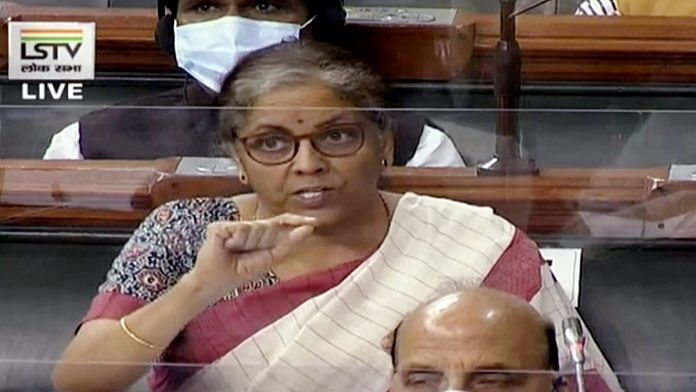New Delhi: The Narendra Modi government Monday sought Parliament approval for additional spending of Rs 1.67 lakh crore in the current financial year as it looks to budget the additional expenditure for its Covid relief package.
While the government had announced a Rs 21-lakh crore economic relief package in phases over the last three months, the fiscal impact of these measures was expected to be at one-tenth of its size at Rs 2-2.5 lakh crore as most of the measures were aimed at boosting liquidity.
On the first day of the Parliament’s Monsoon Session, Finance Minister Nirmala Sitharaman tabled the first batch of supplementary demand for grants in the Lok Sabha seeking gross additional expenditure of Rs 2.35 lakh crore.
Of this, around Rs 68,000 crore will be met through savings from other departments and the remaining Rs 1.67 lakh crore will be an additional cash outgo.
Also read: Why Centre and not states should borrow to resolve GST compensation impasse
The spending
The highest cash outgo is on account of the higher allocations for the rural job guarantee scheme. The Mahatma Gandhi National Rural Employment Guarantee Scheme has been allocated an additional expenditure of Rs 40,000 crore to what was announced in the budget.
Another Rs 33,771 crore has been allocated for cash transfers to women Jan Dhan accounts and in accounts of the old people. The Ministry of Consumer Affairs, Food and Public Distribution has been provided an additional allocation of Rs 16,000 crore for distribution of foodgrains and other expenditure.
Around Rs 14,000 crore has been allocated to the Ministry of Health and Family Welfare in its Covid fight. The government has also allocated Rs 4,000 crore to the National Credit Guarantee Trust Company for guaranteeing Rs 3 lakh crore of loans to micro, small and medium enterprises.
The government has also allocated Rs 46,600 crore for allocation of revenue deficit grants to states as recommended by the Fifteenth Finance Commission. Though the government had accepted the recommendations of the commission to provide Rs 74,340 crore to the states in 2020-21, the allocation made in the budget was only around Rs 30,000 crore.
Amid rising tensions along the Line of Actual Control, the government is also providing additional resources building and maintenance of strategic and border roads.
Among the allocations that will not have a cash outgo include Rs 20,000 crore of recapitalisation of state-run banks.
‘Fiscal deficit will widen’
With revenue contracting sharply and expenditures rising, the government has announced an additional borrowing of Rs 4 lakh crore in the current fiscal. This will raise the total market borrowing by the government to Rs 12 lakh crore in 2020-21. The fiscal deficit is also likely to increase sharply than the initially budgeted 3.5 per cent.
Aditi Nayar, principal economist at ICRA Ltd, said in a note that the eventual fiscal deficit for 2020-21 will be determined by the extent of the savings that can be generated through expenditure management measures in light of the ongoing revenue shock of around Rs 6 lakh crore.
“Our baseline expectation is now that the Government of India’s fiscal deficit will widen to at least Rs 14 lakh crore or 7.4 per cent of GDP in 2020-21,” she said.
Also read: S&P slashes India’s growth forecast to -9% from previous estimate of -5% in FY 2021






